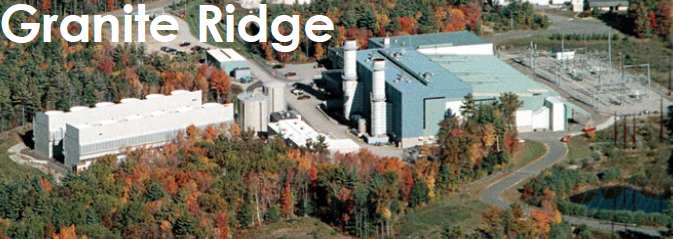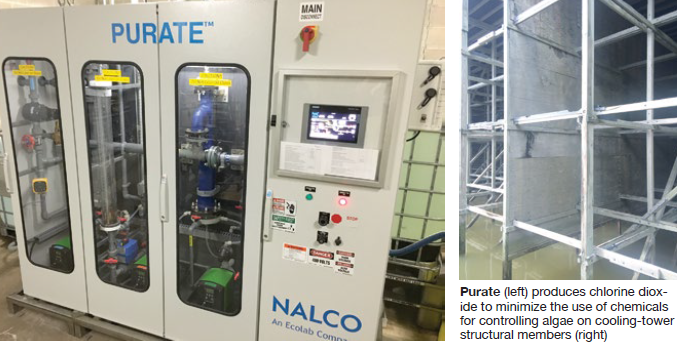Eliminate sodium hypochlorite, bromine, non-oxiding biocides from cooling system
Challenge. The cooling-tower system at Granite Ridge Energy (GRE) relies on treated city wastewater (grey water) for makeup. It contains significant levels of ammonia, phosphate, and total suspended solids (TSS)—including bio-solids.
To control bacteria and algae in the recirculating system, GRE added significant quantities of bleach, activated bromine, two different non-oxidizing biocides (also considered algaecides) and a bio-detergent.
The challenge was to find a safe and environmentally sustainable way to disinfect bacteria and control algae throughout the cooling-tower system—one that would significantly reduce or eliminate the substantial quantity of disinfectant chemicals needed for “complete control” of bacteria and algae.
Specifically, the plant’s objective was to control bacteria (planktonic colonies) in the bulk recirculating tower water as well as bacterial slime (biofilm and sessile colonies) and algae throughout the tower. Staff based its search for a solution on the following information:
- Bacteria in the bulk water are mostly aerobic—pseudomonas, coliform, and legionella—with some anaerobic sulfate-reducing bacteria (SRB). The SRB are most prevalent beneath biofilms and sludge, but if abundant they can also exist in the aerobic conditions of the bulk tower recirculating water. Bacterial colonies found in the bulk recirculating water are also known as planktonic colonies and can be associated with health concerns.
- Bacteria in slime (biofilm) attach to system surfaces such as piping, heat exchangers, and tower fill where they produce the slime to protect the colony and proliferate. Bacterial slime tends to degrade equipment performance and reduce the life cycle of wooden cooling-tower structures. Bacterial colonies found in the biofilm are also known as sessile colonies and can include pseudomonas, coliform, legionella, and SRB.
- Algae attach to cooling-tower structures such as the structural beams, water-dispersing fill media, drift control media, internal walkways and fan shroud areas. They negatively impact tower performance, wooden structures, and safety.
Solution. GRE worked with its water-treatment consultant to develop a safer, more environmentally sustainable approach to reducing their disinfection and algae control chemistry. After investigating several options, staff went with a safe, proven process for generating chlorine dioxide (ClO2) to minimize the use of chemicals at GRE.
The process makes use of existing sulfuric acid, already onsite for controlling tower pH, as well as PurateTM, a proven, stand-alone system that produces ClO2 safely (Fig 1).
Results. Using the Purate ClO2 generator, plant achieved complete control of bacteria and algae throughout the cooling-tower system as summarized below:
- Substantial reduction of bulk-water bacteria (planktonic colonies).
- Significant reduction of bacterial slime and biofilm (sessile colonies).
- Significant reduction of algae on the wooden tower structure, plenum, and fan shroud areas (Fig 2).
- Zero presence of legionella in the bulk water.
- A reduction of 1.5 deg F in differential temperature across the cooling tower through better cleaning of fill and drift-eliminating media.
- Reduced sulfate in wastewater discharge because of decreased use of sulfuric acid.
- Ability to maintain higher pH in cooling tower, because ClO2 is not pH-dependent.
- Even better, staff achieved these outstanding results while establishing safe, environmentally sustainable conditions by eliminating the use of the following chemicals in the tower’s recirculating water system:
- Sodium hypochlorite.
- Activated bromine.
- Two non-oxidizing biocides (algicides).
Personnel also noted that switching to ClO2 generation reduced corrosion in the system by raising the tower pH and contributing less sulfates and chlorides.
Project participants: Jim Barrett
Granite Ridge Energy
Owned by Granite Ridge Energy LLC
Operated by NAES Corp
730-MW, gas-fired, two-unit, 1 × 1 combined cycle (501G) located in Londonderry, NH.
The facility is now owned and operated by Calpine Corp.
Plant manager: William Vogel




